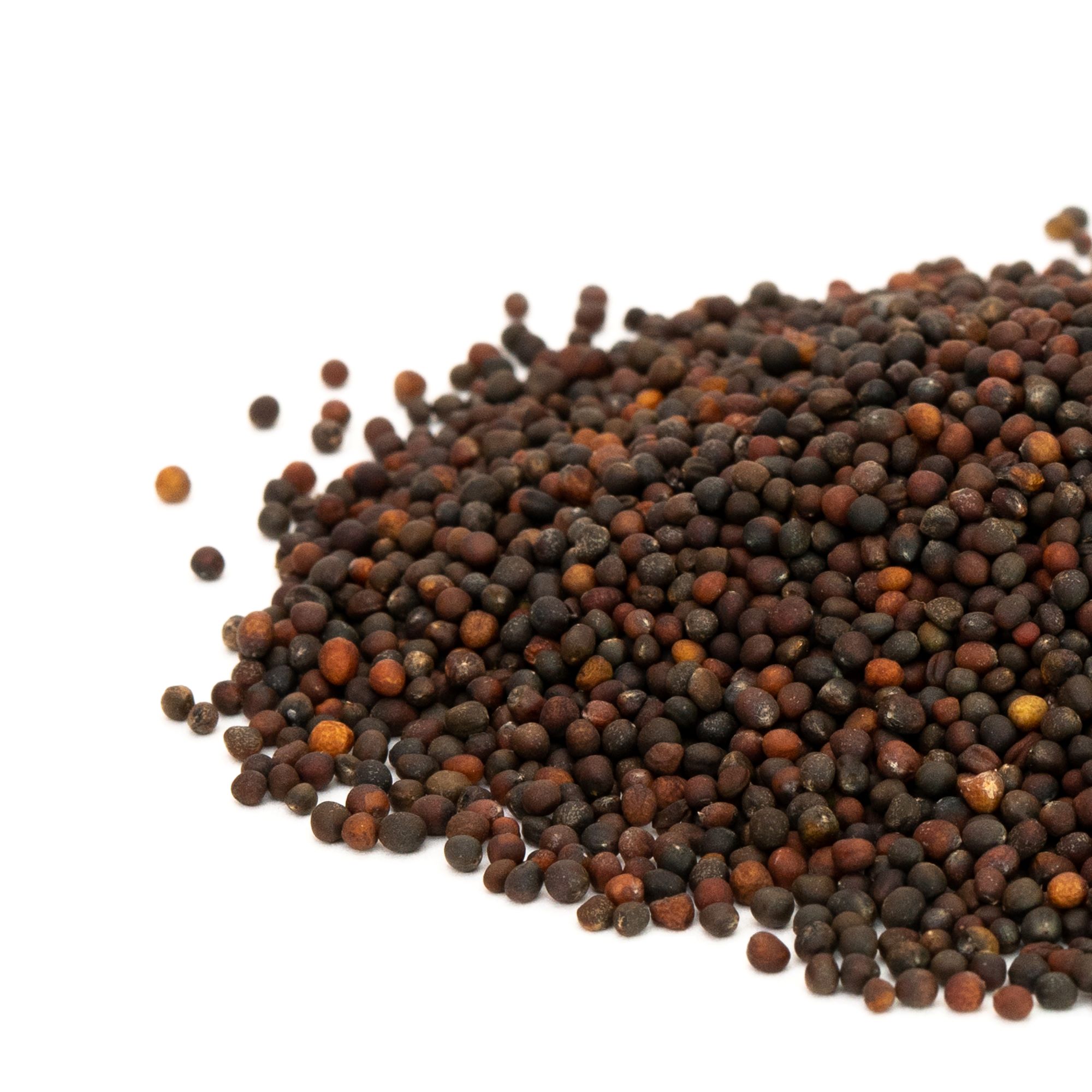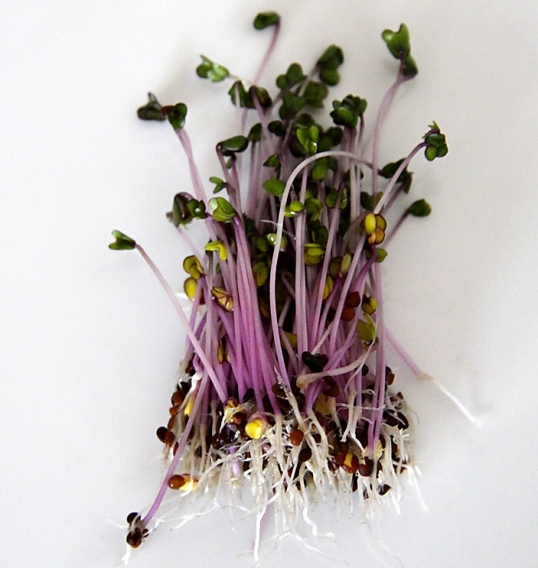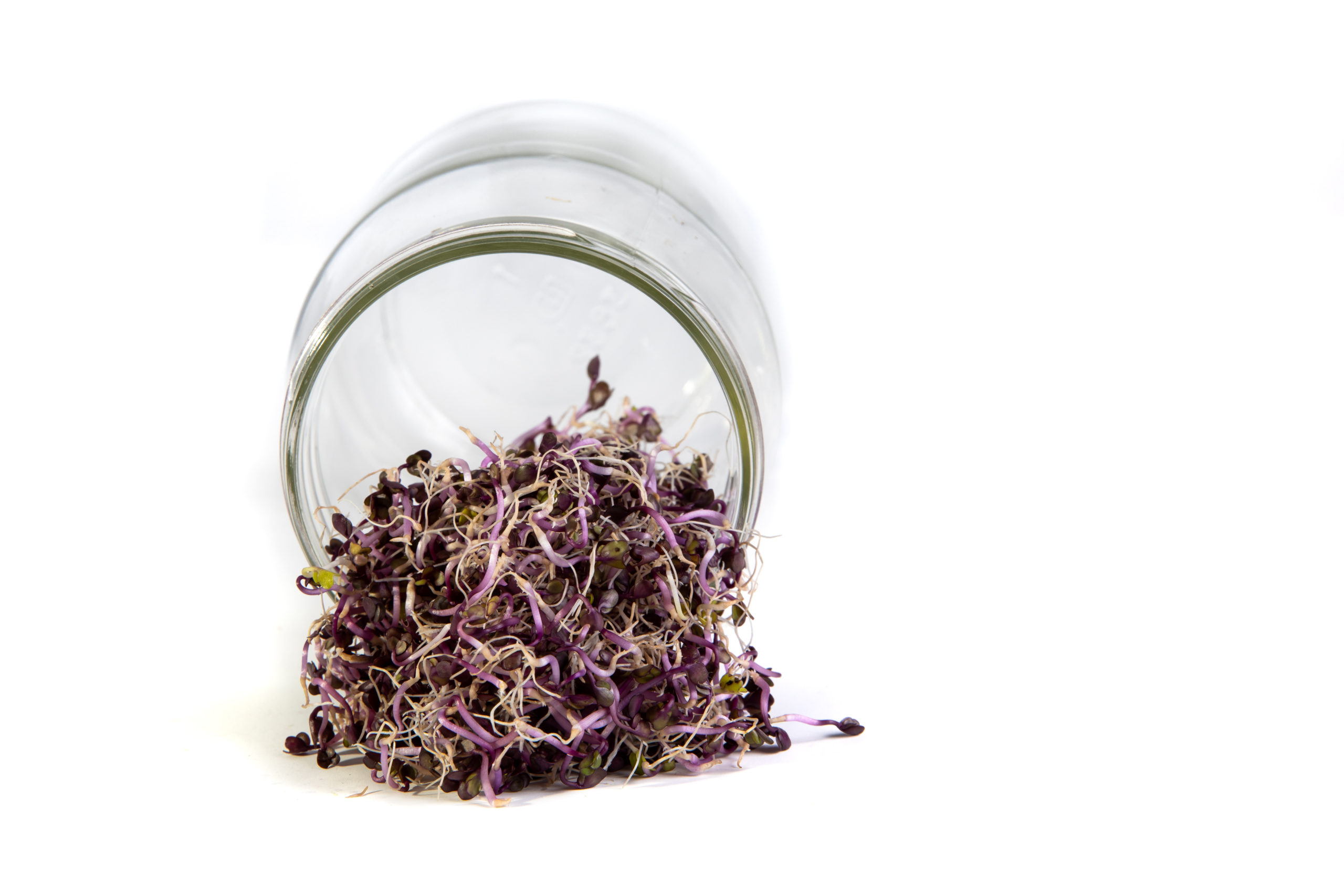Grow red cabbage sprouts or microgreens!
- Days to Sprout: 5 day sprouts, 10-12 day microgreens
- Soak Time: 4-6 hours
- Yield: 1 tbsp of dry seed yields approximately 1 cup of sprouts
- Storage: Our seeds should sprout well for a year after you purchase them, if stored in a cool dry place. If you’d like to extend the germination life of your seeds, store them in the fridge. If you store your seeds in the freezer, they’ll last even longer!
Sprouting Directions
Soak: Put 1-2 Tbsp. seed in a wide mouth jar with a sprouting lid. Add water, swirl, and drain. Refill jar with water and soak 1-2 hours. (Soaking cabbage for longer than 2 hours can cause it to lose germination.) Drain well and invert jar at an angle on a sprouting rack, or in a bowl or drain rack
TIP: After draining, tap the shake the jar gently to remove excess moisture. Rotate the jar and tap gently a few more times.
Rinse: Twice a day, refill jar with cold water, swirl, and drain well by tapping excess water from jar.
Enjoy! Ready to eat in 5 days. Refrigerate to store. (Sprouts store best when they are fairly dry. If you need to store immediately after rinsing, spin dry first.)
Helpful tips:
- Some sprouts tend to clump together as they grow. To separate, fill the jar with water, remove the screen and stir gently with a fork during the regular rinse. Remove hulls if desired. Drain well as usual.
- The drier they are the better sprouts keep. Be sure to let sprouts grow another half day after the final sorting rinse before storing in the fridge. Optional: put folded paper towel on top of the sprouts in the jar. Put lid on and refrigerate turned upside down. This removes excess moisture.
- If your home is very warm during the summer months, it may help to rinse the sprouts three times a day with cold water. Stir gently if clumping.
- To remove the hulls and unsprouted seeds from leafy sprouts, use a special sorting rinse. Pull sprouts out of the jar into a large bowl filled with water. Swish gently using fingers to separate the tangled roots. Most hulls will separate and rise or sink. Discard the hulls. Collect the sprouts back to the jar with or without aid of a strainer. Return the sprouting closure and drain so you can continue for half a day more of sprouting.
- Some brassicas (cabbage family) like radish and broccoli develop very fuzzy root hairs the longer you leave them undisturbed and these can be mistaken for mould. You will even see these after a few days of storage in the fridge. Stirring and rinsing removes the root hairs for a time.
Jar – 5 day Sprouts
Easy Sprouter – 5 day Sprouts
Soil – 12 day beautiful microgreens
Sprouting Directions
Soak: Put 1-2 Tbsp. seed in a wide mouth jar with a sprouting lid. Add water, swirl, and drain. Refill jar with water and soak 1-2 hours. (Soaking cabbage for longer than 2 hours can cause it to lose germination.) Drain well and invert jar at an angle on a sprouting rack, or in a bowl or drain rack.
TIP: After draining, tap the shake the jar gently to remove excess moisture. Rotate the jar and tap gently a few more times.
Rinse: Twice a day, refill jar with cold water, swirl, and drain well by tapping excess water from jar.
Enjoy! Ready to eat in 5 days. Refrigerate to store. (Sprouts store best when they are fairly dry. If you need to store immediately after rinsing, spin dry first.)
Helpful tips:
Some sprouts tend to clump together as they grow. To separate, fill the jar with water, remove the screen and stir gently with a fork during the regular rinse. Remove hulls if desired. Drain well as usual.
The drier they are the better sprouts keep. Be sure to let sprouts grow another half day after the final sorting rinse before storing in the fridge. Optional: put folded paper towel on top of the sprouts in the jar. Put lid on and refrigerate turned upside down. This removes excess moisture.
If your home is very warm during the summer months, it may help to rinse the sprouts three times a day with cold water. Stir gently if clumping.
To remove the hulls and unsprouted seeds from leafy sprouts, use a special sorting rinse. Pull sprouts out of the jar into a large bowl filled with water. Swish gently using fingers to separate the tangled roots. Most hulls will separate and rise or sink. Discard the hulls. Collect the sprouts back to the jar with or without aid of a strainer. Return the sprouting closure and drain so you can continue for half a day more of sprouting.
Some brassicas (cabbage family) like radish and broccoli develop very fuzzy root hairs the longer you leave them undisturbed and these can be mistaken for mould. You will even see these after a few days of storage in the fridge. Stirring and rinsing removes the root hairs for a time.
Grow Microgreens!
Soilless Method
Soak. Using a tray with drainage holes, rinse enough seed to cover the bottom of the tray. Soak the seed for 1-2 hours. Use a jar with a sprouting lid for soaking if the tray holes are too large. Drain, rinse and drain holding at an angle to remove excess water. Spread the seed evenly on the bottom of the tray and cover with a lid top and bottom or put in plastic bag.
Rinse. Rinse with cold water twice a day, using either a gentle flow from a tap, dipping in a sink, or spraying. Drain thoroughly.
Grow. The roots will form a mat from which the microgreens will emerge. At that point, put in indirect sunlight, florescent/LED lights or grow lights. The watering is then easy: fill the container 1 cm deep with water and allow to sit for a few seconds in the water and then tilt on an angle to decant the water until only some moisture is remaining remaining in the root area. Continue to rinse twice a day as described above.
Harvest!
Typically, microgreens grown without soil are harvested at 7-10 days. Harvest before the next expected rinse so the shoots are dry. Harvest before the next expected rinse so the shoots are dry. Harvest microgreens using scissors or knife.
Instead of harvesting all at once, you can start to harvest microgreens as soon as the first two leaves are spread out. Take only what you need for your meal and allow the rest to keep growing or put the tray in the fridge loosely covered and a plastic bag or dome to harvest another day.
Grow Microgreens!
Soil Method (small seed)
• 10” x 20” gardening trays (1-inch-tall preferred), 1 with
holes + 1 without. Smaller microgreen trays also work well.
• Good quality organic starting soil mix
• Parchment paper or unbleached paper towel (optional).
• Dome lids (clear or black) or plastic sheet
• Organic seed
• Mister bottle, cup measures, garden spray nozzle (optional)
• Scissors or sharp knife
1. Don’t soak small or medium size seed. Small seed such as broccoli and arugula are easier to sprinkle on top of the soil if they are not soaked.
2. Prepare Soil
Add water to top of the bag (or each tray) 12 hours ahead of use until almost fully hydrated. Rehydrate the bag as necessary. If you were to put the soil in your hand and squeeze it, you should not be able to get much more than a drop of water out of it for the perfect moisture content. If you want to mist the seed after putting it on the soil, reduce the water hydration of the bagged soil a bit.
TIP: To check for overwatering, tip the tray to one end. Water should not pool enough to drip out of the tray.
3. Fill Trays with Soil
Use a tray with holes. Fill with 3/4-1.5” of soil. The closer to the top of the tray the better aid to air circulation. Use a block or your hand to smooth and flatten the soil without compacting it. The back of a tablespoon or spatula smooths out the valleys. You can wait to put the tray without holes under until after unstacking/uncovering or add it to the bottom now.
TIP: Place a layer or two of paper towel on the bottom of the tray before adding soil for easier cleanup.
4. Sow the Seed
Sprinkle the seed evenly over the soil in the tray (pizza cheese shaker, spoon). The seeding density depends on the stage at which you’re planning to harvest. For small seeds for 1-week microgreens, start with approximately 15 -28 grams (1.5 – 2 Tbsp). Sow slightly less seed for 2-3 week microgreens.
Seeds do not need misting if the soil has enough moisture. Mist if you need more moisture. Use a spray bottle or a garden spray nozzle set to light mist. The soil should be moist throughout, but not soaking wet.
5. Cover the Seed
Doing away with soil as a seed cover decreases the work and time it takes to grow the greens. If stacking the trays on top of each other, use a cover directly on the seed like parchment paper, a plastic sheet or wet unbleached paper towel layer. When not stacking trays, the seed will need protection from drying out by using a dome/lid. Use a clear dome or an inverted 10 x 20” tray without holes. For smaller trays, use several layers of unbleached paper towels folded onto itself with or without a plastic sheet covering the top.
TIP: Most microgreens will grow taller when you keep the light out at the beginning, but this may make the stem weaker. Most seeds germinate in the light no problem.
6. Stack Trays or Cover with Lids
Stacking helps to quickly force the roots into the soil, provides darkness, promotes even germination/growth. Stack 2-5 filled trays on top of each other with an empty tray on the top of the stack with a weight in it. Check at least once a day to see if the trays need water. Cabbage family seed sprouts quickly, so stack for 2-3 days. Others stack 3-5 days.
If choosing not to stack, simply cover the trays with clear or black-out plastic, a lid or dome. Check at least once a day to see if the trays need water. Cover for the same number of days as above.
7. Expose to Indirect Sunlight, Florescent/LED or Grow Lights.
After 2-5 days, the microgreens should be ready for light. If the microgreens begin to get quite tall and leggy, this is an indication that they may need a bit more light.
8. Water the Growing Microgreens
Check the seed once or twice daily and water as needed. The soil should be moist, not wet. Once trays are unstacked, add water from below into the no holes tray as necessary.
9. Harvest!
Microgreens are harvested at 1-3 weeks with scissors or a sharp knife. Make sure microgreens are not damp before storing. If needed, you may use a small fan or salad spinner to dry the microgreens before storing in a sealed container in the fridge.
Instead of harvesting all at once, you can start to harvest microgreens as soon as the first two leaves are spread out. Take only what you need for your meal and allow the rest to keep growing or put the tray in the fridge loosely covered and a plastic bag or dome to harvest another day. Water as necessary.
10. Enjoy!
Microgreens make everything better, so have fun with them and add them to your favourite dishes!
Helpful tips:
• To moisten your bag of soil, add water ahead until almost fully hydrated.
• The roots grow under the soil so it works well to water from below if the tray has holes in it, or open the side of the tray and pour water beside the soil when using flexible plastic trays. Otherwise misting or watering from the top works well too.




Jeff T –
They take a bit longer than some others (10-14 days), and can become mouldy if overwatered, or under-ventilated, but they are well worth it!!! I have never found a thicker, more vibrant and colourful sprout than these. Dark green and purple, with thick chewy leaves, these are packed with goodness of the highest kind (that food can offer :).
Tips: watch YouTube videos on sprouting micro greens for advice. Buy self-watering trays from a garden store to save time and effort. Remove the cover once leaves start to appear. Sunlight seems to help with preventing mould. Don’t spend all your free time staring at them – I know, they’re really beautiful.
AmmyS –
This was very easy to make. The flavor of red cabbage was very evident and it is great on a salad/ and great on its own. It brings a great color to any dish that you serve.
Seeds were easy to ‘harvest’.
Sandi –
I had been looking for red cabbage seeds for a personal sprouting mix for a while, and was very happy to find them at Mumms. The seeds sprouted very well and added brilliant colour and a delightful pungent flavor to my mix. The product arrived on my doorsteps two days ahead of expectation. More than satisfied with my purchase.
Patrick –
Very beautiful cabbage, good flavour, excellent taste
Clover –
Adds nice colour and rich taste
Awesome –
Amazing when grown as a microgreen. The color and rate at which it grows is super impressive.
drl1998 –
I’m very pleased with the with the fast sprouting time and the unique taste.
Bfulton71 –
These seeds are great for sprouting and create healthy organic food.
PlantAddict –
I love these sprouts. Very happy with how easy and fun they are to grow. Great decoration, too.
Shprauter HH –
I love the snappy flavor, and rich color. The taste is wonderful and I like them on soups as well as salads or with crackers and dips.
W. Brown –
Hey guys,
I just wanted to tip my hat to the Mumm’s team. Ordering was super easy, delivery was super quick & the packaging is awesome. The pricing is pretty good too. i’m about to start planting over the next week or so, just need to get the heating source set up in the green house. fingers crossed. An additional special thanks should go to Curtis Stone (The Urban Farmer/ Green City Acres). By watching his YouTube channel I learned that you guys exist. I’ll be sure to let all my friends know here on the east coast. Hoping to push some additional business your way. I’ll be a repeat customer, I’m sure of it.
Thanks
W. Brown
Witty Peasant –
Great taste and added color in my salad! Grows great on Biostrate as a microgreen.
RMD51 –
These seeds don’t produce a large volume of sprouts but are densely packed with vitamins and minerals (about 1/3 the volume of alfalfa). I mix 20% by weight of each red cabbage and fenugreek to the Broccoli Brassica Blend. My standard clover/alfalfa mix is 25% of each – alfalfa, red clover, crimson clover and red cabbage). That mix has a mild but nice flavour. I’ve heard that red cabbage sprout juice is good for hangovers but I’ve had no experience with it.
Viki –
We love this one so much, the taste, texture, and appearance all exceeded my expectations.
Elaine Ellinger –
Sad to say these have been a failure. First lot didn’t grow (perhaps only a 20% germination rate) and after several days dumped them because they got skunky while seeds planted the following day had finished growing and been harvested. Tried again soaking them for less than half the suggested time (because they are Brassicas I felt that 6 hr might be too long) and kept them quite dry (light sprays) while sprouting. Once again they took much, much longer than my other sprouts, had a poor germination rate, only got to about 1/2 inch high after several days and were thickly matted with roots. Not a satisfactory experience. The taste is fine but nothing special – cannot be bothered with these anymore. Perhaps they should be added to mixes and not grown alone like mustard is.
SueBear –
The seeds germinate evenly and quickly. Very tasty in sandwiches and salads. Lovely flavor. Keeps well in the fridge for 3 days
7777 –
These sprouts were a beautiful pink color while the leaves were purple. They grew as quite a compact mass in the sprouting jar. They had a very pleasant cabbage flavor with a bit of a nip. My husband and I both liked them! Very easy to grow.